The de Havilland Vampire is a British jet fighter aircraft designed, developed and produced by the de Havilland Aircraft Company. It was used by the Royal Air Force (RAF) but also by many other users, among them, the following ones:
- Canada: In 1946 the Canadian Government ordered 150 Vampire F.Mk.3 fighter from de Havilland after changing an older plan where local production of the Vampire under license was planned. In fact, one Vampire F.1 was tested at the Winter Experimental Establishment in Edmonton, Alberta.
Eventually, the order was reduced to 85 machines, all of them drawn from RAF's production. They were delivered between September 1947 and February 1948 and Vampires equipped two frontline squadrons of the Royal Canadian Air Force (RCAF), Nos 410 and 421. No.410 operated the type from 1949 until 1951. No.421 was moved to Great Britain to carry out operational training alongside the RAF.
Six Royal Canadian Air Force Auxiliary squadron flew the type too, these were: Nos. 400, 401, 402, 411, 438 and 442 as did the Canadian Central Flying School and No.1 Operational Training Unit.
The Vampire was appreciated among Canadian pilots as it was easy to fly. Between November 1956 and June 1958 they were gradually withdrew from service as they were replaced by the Canadair Sabre. In 1960 fifteen Vampires F.Mk.3 were sold to the Mexican Air Force.
Twenty-six machines, plus four 'spares' (machines intended to be used as a source for spare parts) were sold to an American company based in Wisconsin. This company sought to convert the Vampires into single-seat executive jet or fun flyers, however their project was cut short by sever restrictions set by the American Federal Aviation Administration.A Hollywood stunt pilot, Paul Mantz, is known to have operated two Vampires and one company, Airplanes Inc. of Wyoming, still had one operational machine in 1967. - Chile: On 22nd October 1953 five Vampire T.55 were ordered for the Chilean Air Force (CAF). The first three of which were shipped during January 1954 with the remaining two arriving between April and June. They were assembled and test flown at Cerrillos Air Base, in Santiago. These machines constituted the first jet aircraft of the CAF. They served as trainers. However, by 1962 they were all grounded, to be refurbished, one year later into ground attack planes. They lasted until 1971 when structural life restrictions grounded all the Vampires except for one.
That year, the CAF ordered some Hawker Hunters, but they still had the need for a good basic jet trainer so they bought four ex-RAF T.11s and six ex-Fleet Air Arm T.22s. They were shipped to Chile in December 1972 and took part in the Beagle Crisis in 1974. By June 1977 some were withdrawn from active service with the remaining ones following on 31st December 1980.










.svg.png)




